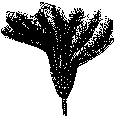DACF Home → Bureaus & Programs → Maine Geological Survey → Explore Maine Geology → Fossils → Remains of Life → Fossils in Bedrock
Fossils Preserved in Maine Bedrock
Introduction
The geologic history that is recorded in Maine's bedrock covers more than half a billion years. Over this period of time a variety of geologic processes including erosion and sedimentation, mountain-building, deformation (folding and faulting), metamorphism, and igneous activity, have acted to produce the complex bedrock geology that we see today.
The theory of "plate tectonics" explains the forces that cause these geologic processes. Simply put, this theory states that the surface of the Earth is made up of a series of "plates" that are constantly in motion. Granted, it's "slow" motion, but over hundreds of millions of years, the earth's continents have moved great distances. The land masses that are in northern climates today may have been in tropical regions millions of years ago. By mapping out the distributions of particular fossils, ancient oceans and continents can be delineated. For example, a certain Mesozoic fossil (Mesosaurus) occurs only in western Africa and in eastern South America, which shows that those continents were next to each other in Mesozoic time. On the other hand, fossils of particular marine shellfish (brachiopods) of Silurian age in coastal Maine and New Brunswick are different from brachiopods of the same age in western New England and northern Maine. This indicates that land that is now connected was not connected in the Silurian. An animated map will help you visualize how the earth's continents have moved over time.
There is a rich diversity of life preserved in Maine's rocks. While most of the deposits are marine, there are some terrestrial deposits, including the world famous Trout Valley Formation from which the State Fossil, Pertica quadrifaria (a plant) comes. Maine's bedrock fossil record is contained in rocks from the Cambrian, Ordovician, Silurian, and Devonian Periods -- a span of time from 545 million years ago to 360 million years ago (refer to the geologic time scale). Over this span of time, the climate and location of "Maine" have changed dramatically. Click on the following links to see a "snapshot" of the location of "Maine" and the climate during the time periods indicated:
| Millions of years ago | Location of continents | Climate |
|---|---|---|
| Present day | Modern | |
| 360-417 | Devonian | Late Devonian Middle Devonian Early Devonian |
| 417-440 | Silurian | Silurian |
| 440-505 | Ordovician | Middle and Late Ordovician Early Ordovician |
| 505-545 | Cambrian | Middle and Upper Cambrian Early Cambrian |
Unfortunately there is a significant gap in Maine's fossil record from approximately 360 million years ago to about 1 million years ago. This gap is most likely the result of episodes of mountain-building and erosion which removed the record of rocks formed during this time period. Most recently, continental glaciers scoured the landscape, removing more sediment and rock. While this erosion was helpful in exposing the older, Paleozoic rocks, it completely removed all of the Mesozoic material and a large portion of the Cenozoic record.
Common Fossils Found in Maine Bedrock
Click image thumbnail in right column for a larger view.
Credits for line drawings:
Stromatoporoid - Boardman, R. S., Cheetham, A. H. and Rowell, A. J. (editors), 1987, Fossil Invertebrates: Blackwell Science, MA, p. 124.
Coral - Moore, R. C., Lalicker, C. G. and Fischer, A. G., 1952, Invertebrate Fossils: McGraw-Hill Book Company, Inc., NY, p. 124.
Brachiopod - Moore, R. C., Lalicker, C. G. and A. G. Fischer, 1952, Invertebrate Fossils: McGraw-Hill Book Company, Inc., NY, p. 240.
Bivalve - Moore, R. C. (editor), 1969, Treatise on Invertebrate Paleontology, Part N, Volume 1, Mollusca - Bivalvia: Geological Society of America and the University of Kansas, p. 300.
Snail - Moore, R. C. (editor), 1960, Treatise on Invertebrate Paleontology, Part I, Mollusca - Gastropoda: Geological Society of America and the University of Kansas, p. 191.
Crinoid - Babcock, L. E., 1996. Chapter 7- Phylum Cnidaria, in Feldman, R. M. (editor), 1996, Fossils of Ohio: Ohio Division of Geological Survey, Bulletin 70, p. 251.
Trilobite - Moore, R. C., Lalicker, C. G. and Fischer, A. G., 1952, Invertebrate Fossils: McGraw-Hill Book Company, Inc., NY, p. 491.
Graptolite - Bulman, O. M. B., 1970, Treatise on Invertebrate Paleontology, Part V, Graptolithina: Geological Society of America and the University of Kansas, p. 133.
Trace Fossil - Orr, P. J. and Pickerill, R. K., 1995, Trace fossils from Early Silurian flysch of the Waterville Formation, Maine, USA: Northeastern Geology and Environmental Sciences, v. 17, no. 4, p. 399.
Last updated on January 8, 2008

















